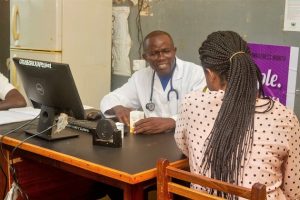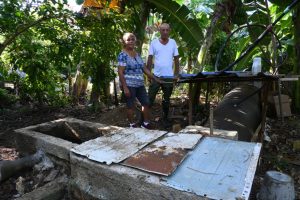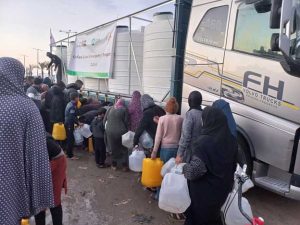The Human Consciousness Now...Our World in the Midst of Becoming...to What? Observe, contemplate Now.
NAIROBI, Apr 29 2024 (IPS) - The World Health Organization’s African regional office and partners published over 25 peer-reviewed articles in scientific journals in 2023 as part of efforts to address the imbalance in global research and ensure that Africa was better represented in the production of health research academic literature, a new report shows.
The office, through its Universal Health Coverage, Communicable and Non-Communicable Diseases (UCN) Cluster, published on a range of health challenges and diseases, including the risk of zoonotic disease in countries ranging from Uganda, Malawi, Tanzania, Ghana, and Nigeria, investigating infectious and non-infectious diseases, and public health approaches to ease Africa’s disease burden.
This research is critical to the continent, says Africa’s Regional Director, Dr. Matshidiso Moeti.
“The WHO African Region arguably bears one of the greatest burdens of disease globally. This has always been exacerbated by poverty, which, in the decade prior to COVID-19, was on the decline. Now, however, these gains have been reversed, not only by COVID-19 but by a series of severe shocks during the 2020–2022 period,” said Dr. Matshidiso Moeti, the Regional Director for Africa,” she told IPS.
“Major threats include climate change, global instability, slowing economic growth, and conflict. This makes it ever more important that we at the WHO Regional Office for Africa focus on the central promise of the 2030 SDG agenda, which is to ‘leave no one behind’, using a health systems strengthening approach to move towards universal health coverage.”
According to the Ending Disease in Africa: Responding to Communicable and Noncommunicable Diseases 2023 report released in April, WHO scientists were able to publish their work in reputable journals, including the Social Sciences and Humanities Open, supporting Africa’s efforts to raise her scientific research production, estimated at only 2 percent of the world’s total.
The works also found homes in open access journals, including America’s Public Library of Science (PLOS), where they are accessible for free by the scientific community and the general public.
Besides Africa-based scientific publications such as the Nigerian Journal of Parasitology, highlighting the need to support the role local publications can play in elevating African science and, by extension, helping address imbalances in global research.
“A country’s ability to create, acquire, translate, and apply scientific and technological advancements is a major determinant of its socioeconomic and industrial development. Many of Africa’s current and future health challenges can only be addressed by conducting research on population-based approaches towards effective disease prevention and control, which are then translated into policy and practice,” the report noted in introducing the work.
“Despite Africa’s disproportionate burden of disease, the region produced 0.7 percent of global research in 2000, 1.3 percent in 2014 and an estimated 2 percent more recently. In response, the UCN Cluster and partners published over 25 peer-reviewed articles in scientific journals in 2023 as part of efforts to address the imbalance in global research, and ensure regional representation in academic literature.”
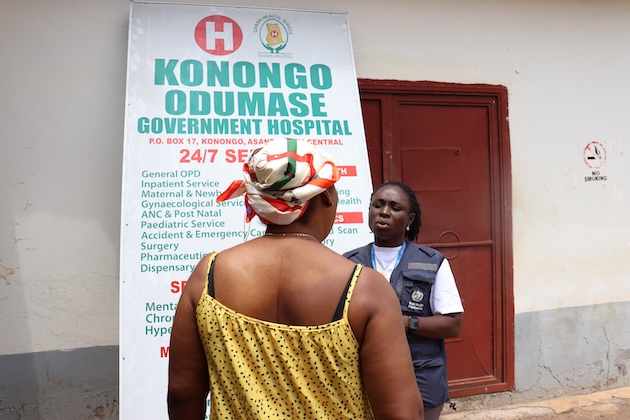
According to the Ending Disease in Africa: Responding to Communicable and Noncommunicable Diseases, WHO scientists were able to publish their work in reputable journals, supporting Africa’s efforts to raise her scientific research production, which is estimated at only 2 percent of the world’s total. Credit: WHO
In Ghana, the WHO team conducted a “community-based cross-sectional study” to investigate occurrences of skin ulcers, whose findings showed the importance of integrating multiple skin diseases on a common research platform in findings published by PLOS One, while in Tanzania, a “spatio-temporal modelling” of routine health facility data to better guide community-based malaria interventions on the mainland was done.
Some of the papers the WHO-Africa says were examples of “operational and implementation research,” conducted to identify and ensure the successful adoption and adaptation of evidence-based interventions in both clinical and public health on the continent.
They include findings from an impact assessment of a school-based preventive chemotherapy programme for neglected tropical diseases (NTDs), schistosomiasis, and soil-transmitted helminth control in Angola, where used drugs were found to have little impact in controlling the diseases. These findings were published in PLOS Neglected Tropical Diseases.
“This highlighted the need for a comprehensive understanding of individual, community, and environmental factors associated with transmission and consideration for a community-wide control programme,” it concluded.
The Springer Nature’s Malaria Journal published the team’s research on treatment-seeking behavior among parents of children with malaria-related fever in Malawi. It captured the need for targeted health interventions among communities in low socioeconomic settings and those living far from health facilities.
In Nigeria, an article based on experiences in Nigeria using a novel schistosomiasis community data analysis tool, developed by the UCN Cluster, emphasized the usefulness of the tool for strategic planning purposes, allowing the tool to be deployed around Africa for the management of the disease. Blood flukes (trematode worms) from the genus Schistosoma are the primary cause of the acute and chronic parasitic disease schistosomiasis.
Research on health policy and systems, the aim being to better understand how “collective health goals” are reached. This was done through a range of disciplines, including economics, sociology, anthropology, political science, and public health.
One such journal article was published by Elsevier’s Social Sciences and Humanities Open, looking at five decades of infectious disease outbreaks on the continent and recommending that concerted public health action may help reduce outbreaks, as well as drawing important conclusions for disease preparedness and prevention activities.
Quite critically, the experts undertook “knowledge translation” work, the application of knowledge by various actors to deliver the benefits of global and local innovations in strengthening health systems and improving health.
“In the African context, knowledge translation generally includes an aspect of localization, considering local perspectives and approaches and the effects of the social, cultural, political, environmental, and health system context on an intervention’s impact,” the experts explain.
In 2023, the UCN Cluster translated and localized several global knowledge products for use in Africa, including one on oral diseases, a malady suffered by about 44 percent of the population in the region.
Africa, the document observes, has experienced the “steepest rise globally in oral diseases over the last three decades,” even as spending on treatment costs remains “extremely low,” thus the need to share the newest information on their management.
Away from scientific research, the report reveals that Mauritius became the first country in Africa to fully implement WHO’s package of tobacco control measures, while at the same time WHO-Africa launched an initiative to support better access to breast and cervical cancer detection, treatment, and care services in Côte d’Ivoire, Kenya, and Zimbabwe.
Equally important, WHO Africa, in collaboration with Nigerian authorities, introduced the human papillomavirus (HPV) vaccine into routine immunization schedules, targeting more than 7 million girls, the largest number in a single round of HPV vaccination in Africa.
Success stories emerged in Algeria, which successfully ‘interrupted’ the transmission of schistosomiasis after reporting zero indigenous cases for the past three years, in January 2024, and in Cape Verde, which became the third country to be certified as malaria-free.
Note: This article is brought to you by IPS Noram in collaboration with INPS Japan and Soka Gakkai International in consultative status with ECOSOC.
IPS UN Bureau Report
WASHINGTON DC, Apr 29 2024 (IPS) - Latin America’s workforce grew by nearly 50 percent in the two decades before the pandemic, helping boost economic growth. Now demographic trends are turning, and likely to weigh on growth in the coming years.
We expect growth in Latin America to average about 2 percent per year in the next five years, below its already low historical average. These projections are also considerably weaker than those for other emerging market economies across Europe and Asia, which are also expected to slow but still grow by 3 percent and 6 percent annually, respectively.
This weaker outlook party reflects long-standing challenges of low investment and slow productivity growth. The additional challenge this time is that the demographics are turning, and the labor force won’t grow as fast as before.
Turning Demographics
Population growth will continue decelerating, falling from about 1 percent per year in the two decades preceding the pandemic to about 0.6 annually in the next five years. This is not necessarily bad news as a growing population does not automatically mean rising income per capita—the most relevant measure of wellbeing.
Although a larger population means a larger labor force and aggregate output, it also means a larger number of people among whom output is shared. Still, growing the economy through a larger population can help in other ways, including by increasing revenues to repay high debt levels.
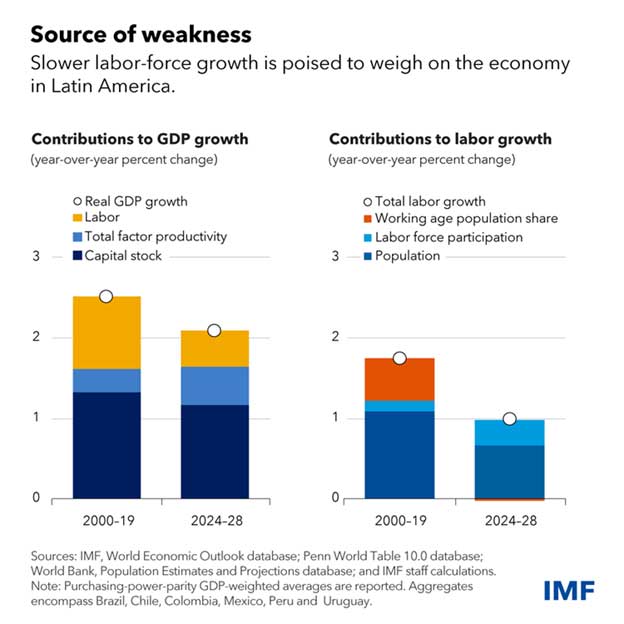
More importantly, the demographic dividend is fading as the region’s population is aging and the share of the working-age population is peaking. This means that the share of the population able to generate income will stop growing. It is an important change as this share had been growing until now, enabling the labor force to grow 0.5 percent per year since 2000. In contrast, we expect no growth in the share of working-age population over the next five years, on average.
Boosting participation
Keeping the labor force engine running will require boosting labor force participation. And some of this is expected to happen, as the share of working-age jobseekers is projected to continue rising.
But for this to become a reality, it will be key to further integrate women into the labor force. Their participation remains low, at only 52 percent of working-age women compared to 75 percent of men.

Policies can help. Expanding childcare programs and providing more training for women can help raise female participation, as we have discussed in recent country reports, including for Brazil and Mexico.
Ensuring that household taxation does not discourage secondary household earners and eliminating asymmetric childcare and parental leave benefits between men and women, that ultimately discourage hiring of women or affect their pay, can also help bring more women into the labor force.
Countries can also grow their workforce by providing vocational training opportunities, raising the retirement age, eliminating disincentives for work after retirement and adopting policies that facilitate employment of older workers.
Tackling crime—an important factor behind migrant outflows in some parts of the region—should also be on the agenda.
But also, as demographics become less favorable, countries will need to put more effort into raising labor productivity growth, by tackling poor governance, stringent business regulations, and widespread informal work (which constrains firms’ growth and the associated productivity gains).
This will help raise living standards even amid demographic headwinds.
Latin America’s many years of hard work to strengthen macroeconomic frameworks has paid off. Countries successfully navigated the last two large global economic recessions and avoided a painful repeat of past crises.
Now they must take advantage of this resilience to focus on boosting potential growth, a persistent challenge that’s mounting as demographic fortunes turn.
Source: International Monetary Fund (IMF)
IPS UN Bureau
HAVANA, Apr 26 2024 (IPS) - Just to obtain a good fertilizer it was worth building a biodigester, says Cuban farmer Alexis García, who proudly shows the vegetables in his family’s garden, as well as the wide variety of fruit trees that have benefited from biol, the end product of biogas technology.
García and his wife Iris Mejías organically grow all the agricultural products that make them self-sufficient, on the land around their home in the semi-urban neighborhood of Sierra Maestra, in the municipality of Boyeros on the south side of Havana.“We need a greater culture and awareness about renewable energies. There is resistance among some places and people. On the other hand, there are the high prices which do not foment the rapid expansion of technologies and equipment.” -- Alexis García
“I used to use a little urea, but because of the economic situation it has become very difficult to import this and other fertilizers. The bioproducts are an opportunity to make up for that shortage and, in some cases, function as pesticides,” García, a 62-year-old retired university professor who is now dedicated to his crops, told IPS.
Biol is the liquid effluent with a certain degree of stabilization that comes out of the biodigester, once the process of anaerobic digestion of organic matter, which includes animal manure, crop waste and/or liquid waste, has been completed. It is rich in nutrients for crops and for restoring soil through fertigation.
García pointed out that the challenges of obtaining energy and the need to process manure prompted the installation of the geomembrane biodigester, which as of December 2023 provides about four cubic meters of biogas per day.
This is one of the three types of biodigesters most used at a small and medium scale in Cuba, together with the mobile type, also known as the Indian model, and the fixed dome or Chinese biodigester.
“I had read a little about it and wanted to have a biodigester. With some savings we decided to start building one. In addition to the support of our sons Alexis and Alexei, we had the backing and advice of José Antonio Guardado,” coordinator of the Biogas Users Movement (MUB), said García.
Founded in 1983, the MUB brings together some 3,000 farmers who use this technology in this Caribbean island nation of 11 million people.
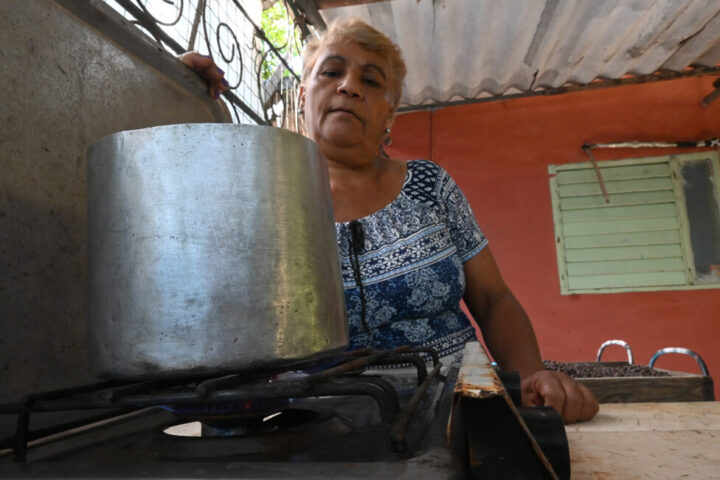
Preschool teacher Iris Mejías uses biogas to cook food, which gives her autonomy, saves money and improves the quality of life in her home in the south of the Cuban capital. CREDIT: Jorge Luis Baños / IPS
Biogas opportunities
Mejías, 59, said that “with biogas you lose the fear of not having enough fuel for cooking. It provides security.”
Meiías, a teachers at a preschool for the young children of working mothers, says that when the economic crisis became more severe in the 1990s, she cooked with firewood, charcoal, kerosene and even coconut shells to prepare her family’s daily meals.
“If you cook with electrical equipment, you depend on the power supply, or if you have a gas cylinder (liquefied petroleum gas), you worry that it will run out and you won’t have a spare. In both cases the biodigester saves money,” she said.
Mejías said it is easier to cook food for domestic animals and heat water “without smut or smoke that makes it necessary to wash your hair every day or makes it difficult to take care of your hands.”
Studies show that methane is a potent greenhouse gas, with a warming power 80 times greater than that of carbon dioxide (CO2).
Proper management of the biological methane resulting from the decomposition of agricultural residues and manure can generate value and be a cost-effective solution to avoid water and soil contamination.
Therefore, its extraction and use as energy, especially in rural and semi-urban environments, can be a solution to reduce electricity consumption and help combat climate change.
According to García, the island could receive greater energy benefits if there were clear incentives for the installation of biodigesters.
Although the acute domestic economic crisis has had a very negative impact on the national swine and cattle herd, “many dairies and pig farms do not know what to do with the daily output of manure. In fact, our biodigester is fed from nearby facilities where it is piled up and they give it to us for free,” he said.
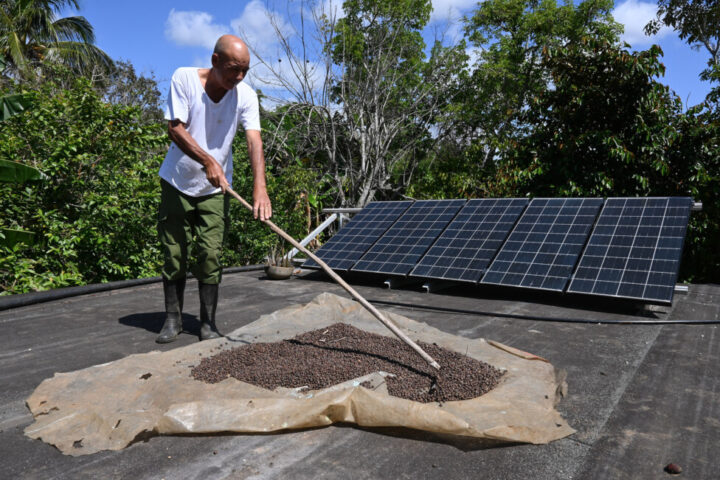
Alexis García dries coffee beans next to solar panels installed on the roof of his house in southern Havana. The possibility of storing energy with the back-up of recovered batteries provides the family with approximately three hours of autonomy during blackouts. CREDIT: Jorge Luis Baños / IPS
Other incentives
Cuba has a biogas production potential of 615,595 cubic meters per year from agricultural and industrial production, according to the Bioenergy Atlas 2022.
That volume represents 189,227 tons of oil equivalent per year or 710,095 megawatt hours (MWh) per year. Of the total, 63 percent comes from agricultural production, he said.
In García’s opinion, Cuba’s rural environment “is in a better position to achieve the desired energy independence. But economic facilities would be necessary, such as loans for the construction of biodigesters, bonuses for people to produce that energy and access to buy lamps, pots and even refrigerators that use biogas.”
Of Cuba’s 11 million inhabitants, about 23 percent, some 2.3 million people, live in rural areas, according to official statistics.
On the other hand, it is estimated that there are some 5,000 biodigesters on the island, although conservative estimates by specialists consider it possible to expand the network to 20,000 family units.
Experts argue that the direct use of biogas is more efficient than transforming it into electricity.
A significant percentage of Cuba’s four million households use electricity as the main energy source for cooking and heating water for bathing, which represents about 40 percent of consumption.
Cuba is a country highly dependent on fuel imports.
During the last five years, in parallel to the deterioration of the domestic economic situation, the decline of the main sources of foreign currency and the strengthening of the U.S. embargo, the authorities have faced increasing difficulties in meeting the demand for fuel.
About 95 percent of Cuba’s electricity generation relies on fossil fuels. The government aims to increase clean sources from the current five percent to around 30 percent of electricity generation by 2030.
“Imagine what it would mean if not all, at least most of the houses in the Cuban countryside had a biodigester or solar panels. Any strategy that encourages independence from the national power grid, or that provides energy, would be very positive,” said García.
In recent years, the international Biomas-Cuba project (2009-2022) focused on helping to understand the importance of renewable energy sources in rural environments, the role of on-farm biodigesters and waste treatment systems in swine facilities.
The initiative, financed by the Swiss Agency for Development and Cooperation (Cosude), was coordinated by the Indio Hatuey Experimental Station, a research center attached to the University of the western province of Matanzas, and involved related institutions in several of the country’s 15 provinces.
Ministerial Order 395 of the Ministry of Energy and Mines of 2021 stipulated that each of Cuba’s 168 municipalities must have a biogas development program and strategy, and coordinate its management and implementation with their respective provinces.
In addition, the non-governmental Cuban Society for the Promotion of Renewable Energy Sources and Respect for the Environment (Cubasolar), together with the MUB, encourages training workshops and the advice of specialists.
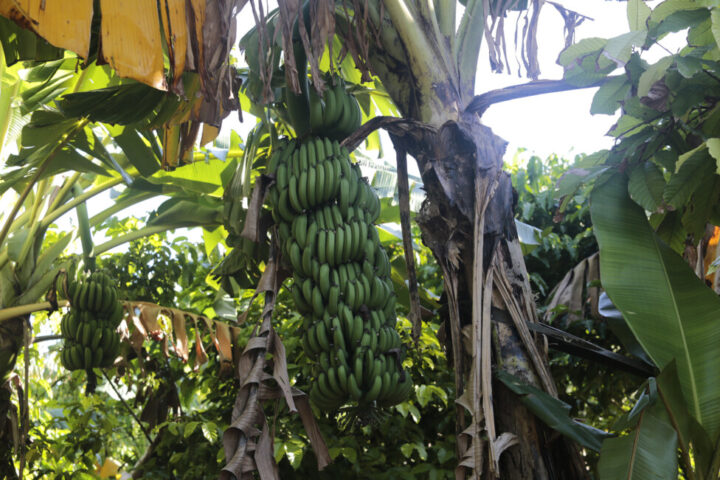
Banana clusters can be seen growing in the backyard of the García-Mejías home in southern Havana. Both the vegetables in the nursery and the fruit trees benefit from biol, the end product of biogas technology, which provides fertilizer. CREDIT: Jorge Luis Baños / IPS
Moving towards energy independence
One of the aspirations of the García-Mejías family is to achieve energy sustainability for their home and agricultural production.
“We foresee the construction of a second biodigester, but this one will have a mobile dome, which should provide two cubic meters of biogas per day, but much more efficiently, and with a higher pressure. With a higher volume we can benefit some neighbors,” García said.
On the roof of their house, six 720-watt solar panels backed up by recovered batteries give them autonomy of approximately three hours of electricity in the event of a power failure.
“We plan to install a wind turbine, as well as a solar heater made of plastic pipes. We want to set up a demonstration area in the house to show the advantages of renewable energies and demonstrate how everything we do is done using these energy sources,” said the former professor.
“We need a greater culture and awareness about renewable energies. There is resistance among some places and people. On the other hand, there are the high prices which do not foment the rapid expansion of technologies and equipment,” García said when IPS asked him in his home about the obstacles to increasing the household use of renewables.
“People hear about the biodigester and think it’s difficult. It takes a little work, but then the benefits are many. There is a lack of information in the media. People come to us looking for help in building biodigesters. We also receive students, which opens up an opportunity for the new generations to grow up with the culture of using nature in a sustainable way,” he added.
COTONOU/BENIN , Apr 26 2024 (IPS) - A group of young girls aged between 15 and 17 sit tight, following attentively a lesson being taught by a Mualim (Islamic teacher) in a makeshift madrassah (Qur’anic school) located in one of the impoverished townships of Benin’s economic capital, Cotonou. They arrived in Benin recently, fleeing poverty, hunger, climate change, and rising insecurity in their home country, Niger, in the aftermath of the military coup that toppled democratically-elected president Mohamed Bazoum.
Among them are Saida, 15, and Aminata, 16, who are already “married” to Abdou, 22, and Anwar, 25, two Niger youths who have been living in Benin for some time. The lessons are over and Saida heads outside the overcrowded compound where her husband, Abdou, came to pick up his wife on a rundown motorbike.
“She has not been feeling well lately and I think she might be pregnant,” Abdou says without embarrassment. Asked about the circumstances leading to the couple becoming husband and wife, he says: “If in Benin or where you come from, this seems strange, it is normal in Niger for a young girl to become someone’s wife as soon as she reaches 15.”
Niger has one of highest prevalence rates of child marriages in the world, where 76% of girls are married before their 18th birthday and 28% are married before the age of 15, according to Girls Not Brides figures.
Child marriage is most prevalent in Maradi (where 89% of women aged 20–24 were already married by age of 18), Zinder (87%), Diffa (82%) and Tahoua (76%). Girls as young as 10 years old in some regions are married, and after the age of 25, only a handful of young women are unmarried, according to the Girls Not Brides statistics.
Steady increase
However, Abdou says there has been a steady increase in such cases since the military coup due to the social and economic meltdown triggered by regional and international sanctions, which left Niger’s economy hanging in balance. France, a former colonial power, suspended development and budget aid to Niger, vowing not to recognize the new military authorities. In 2021, The French Development Agency (AFD) committed €97 million to Niger. Moreover, the World Bank recently warned that 700,000 more people will fall into extreme poverty this year in Niger. In addition, nearly two million children could be out of school, including 800,000 girls.
Multiple suspensions of development aid from several countries and organizations will result in a shortfall of nearly US$1.2 billion in 2024 (more than 6% of the country’s GDP).
“Life has become unlivable since the coup and the closure of borders. In addition, insecurity has risen, forcing farmers to stay away from their fields. In other parts, climate change has rendered farmland useless; it is a triple tragedy for Niger, but the authorities continue to talk nonsense on TV,” says a Benin-based Islamic teacher identified only as Oumarou, who fled to Cotonou in the aftermath of the coup.
“And as a result, many families are left penniless and dependent on humanitarian assistance. Consequently, some families are seeking help from their relatives and family friends living in Benin and Togo to take their daughters under their care. Niger’s people help each other a lot and prioritize community life over individual interests.
“The girls arrive in these two countries and are quickly dispatched to Niger’s households, where they work as domestic workers without pay. Yes, they don’t get paid because they eat and sleep there and are made to feel as if they are part of the family.”
However, Oumarou says that as time goes by, these people begin to feel that they can no longer carry the burden. That is where they pass a message through the elders to Niger youths who want a wife to come and discuss.
Suitors wanted
“As soon as a suitor is found, we inform the girls’ parents, who, in most cases, do not hesitate to allow the marriage to proceed. As God-fearing people, we cannot let the youth take a girl without doing a formal religious ceremony.
Asked if he was aware that he was committing a crime by acting as an accomplice to child marriages, he became defensive and politicized the issue: “What’s criminal and illegal in that procedure? How can you describe our good gesture to help these poverty-stricken girls rebuild their lives as a crime?
“Okay, if it’s indeed a crime. How do you say about France, which has been stealing our natural resources, notably our uranium, for decades without giving us anything in return? And what about the crimes committed by the West during the colonial era in Africa? Did anyone investigate those crimes and bring the perpetrators to book or make reparations for what they did?” the man said, storming out of the room where the interview was taking place.
However, not everyone in Niger is God-fearing and therefore does not follow the religious procedure. Anwar says her wife told him that she owes him her life after rescuing her from the abusive family where she was working as a donkey.
“I have been taking care of her ever since as a wife and a little sister. I don’t need anyone’s permission or blessings to make her my wife. We have been living under the same roof since last year and that’s a sign of marriage,” he says with a wide smile.
Aminata describes the hell she went through while working for one of these families. “They make you work like a slave, right from Fajr [Islamic dawn prayer] up to Isha [evening prayer] and even beyond. It’s very stressful. Most of the time, you don’t even eat well. They keep yelling at you whenever you make a slight mistake. Anwar is a good man and a caring husband,” she says through a translator.
Anwar says most of these girls do not have a formal (western) education. “That’s why they cannot understand French. They only speak their vernacular language and some Arabic because they only attend Qur’anic school.”
Niger has one of the highest illiteracy rates in the world, and very few girls attend formal school, as priority is given to boys. The Niger literacy rate for 2021 was 37.34%, a 2.29% increase from 2018.
Factors that contribute to this, including high dropout rates, high illiteracy rates, insufficient resources and infrastructure, unqualified teachers, weak local governance structures, and high vulnerability to instability, have been blamed for the low level of educational attainment, according to the United States Agency for International Development (USAID).
“I want to ensure that she gets a good education now that she is in Benin, far away from that rotten country, where the system does not allow girls, especially in the rural areas, to attend school,” Anwar, who himself did not finish high school, says.
Niger girls no longer “God-fearing”?
While child brides jostle for makeshift husbands to take care of them away from their impoverished and famine-hit country, in other parts of Benin, street life has become the way of survival for some Niger women. “Niger men used to mock us, saying that their women were God-fearing and not immoral like us. Now the trend has been reversed. Look at the way those two Niger girls out there are shoving for a wealthy client,” Susan, a Beninese sex worker, says.
She claims the girls arrive in the “workplace” every evening well covered from head to toe but take it off and put on some sexy clothes, only to wear them again after the end of the shift. “Now, who fears God the most? The hypocrites or the people like us who have nothing to hide?”
Prostitution is illegal but remains prevalent in big cities and near major mining and military sites. UNAIDS estimates there are 46,630 sex workers in the country. Some sources say poverty, forced marriages, rising insecurity, and climate change continue to push many girls into prostitution, sometimes with the complicity of their families and marabouts (witchdoctors).
A source close to Nigerian and Ivorian pimping syndicates says there is a huge appetite for Niger girls in several countries across the region, including Nigeria, Côte d’Ivoire, Benin, and Ghana. Asked why it is the case, the source says: “From what I heard, girls from other countries, including Benin, Togo, Ghana, and Nigeria, have been used many times and are big-headed, while Niger girls seem fresh, disciplined, respectful, and docile. That’s why they make good wives. The demand has been growing since the coup.”
The source says the three countries (Mali, Burkina Faso, and Niger) desire to quit the regional bloc, Ecowas, will have a negative effect on the sex trafficking business as it will curtail the free movement of people and goods across the region. According to a 2022 report by the International Organisation for Migration (IOM), women and girls constitute 69% of victims and survivors of trafficking in Niger.
While Niger’s military authorities reinforce their grip on power and castigate the West’s neo-colonialist and imperialist attitude and Ecowas’ interference in Niger’s internal affairs, life seems to be getting harder in this uranium-producing West African nation, forcing thousands of underage girls and women to seek a better life elsewhere.
A researcher who recently returned to Benin from Niger says: “You must live in Niger right now to understand what is going on there. Forget what you see on state TV. If residents of the big cities, like the capital Niamey, are trying harder to stay alive, many people are hopeless in the countryside because the humanitarian situation is terrific.
“Those who say development aid does not work are lying because they have never been on the ground to see for themselves.”
Note: The names have been changed to protect their identities.
IPS UN Bureau Report
PHILADELPHIA, Pennsylvania, Apr 26 2024 (IPS) - As we pass 200 days of war, the population of northern Gaza is teetering on the brink of mass starvation. Oxfam analysis found that the 300,000 people in northern Gaza had been forced to survive on an average of 245 calories per day from January to March—less than a single can of beans, and well below the recommended daily intake of 2,100 calories.
While we have seen an uptick in the flow of aid entering Gaza in recent weeks, the trickle of humanitarian assistance combined with an absence of commerce and public services are nowhere near sufficient to address widespread hunger or the shelter, hygiene, and sanitation conditions that are fatal in these circumstances.
The last report from the Integrated Phase Classification system, the official body that collects and analyzes food security data, found that would occur in northern Gaza by May at the latest. Dozens of children have already died from starvation and malnutrition, often worsened by disease, and two out of the three criteria for declaring famine have already been met.
Since an official declaration is a lagging indicator, it is quite possible that famine already exists in areas of northern Gaza. We cannot wait for a famine declaration to act to prevent the needless, widespread death of civilians,
While the threat of starvation is most severe in the north, malnutrition is ubiquitous throughout Gaza. The IPC’s report in March found that almost everyone in Gaza was facing “high levels of acute food insecurity,” with 95% of the population in a Phase 3 food crisis or worse. In the month since the report was release, conditions have deteriorated further.
In addition to the limited availability of food, the ability to find or buy a nutritious, varied diet is not feasible across Gaza. For the little fruit and vegetables still available, extreme price rises due to scarcity have put them out of reach for most people. Specialized nutrition products and centers to treat malnourished children are difficult or impossible to find.
Despite the overwhelming evidence of extreme hunger, the government of Israel’s obstruction of humanitarian access persists. But denial of humanitarian access is not the only issue. While increasing the quantities of food entering Gaza would be a welcome step, a proper response to this catastrophe simply cannot be implemented under present conditions.
Hunger and its impacts are not only due to lack of food, but also are exacerbated by Israel’s near-complete destruction of Gaza’s civilian infrastructure. Over 200 days of incessant bombardment has decimated Gaza’s healthcare infrastructure, water and sanitation services—including Oxfam-supported projects—and emergency response support, leaving people even more vulnerable to deadly disease.
The government of Israel has not restored the flow of electricity and has dramatically curtailed the importation of fuel, without which wells, water treatment facilities, bakeries, hospitals, and individual businesses and households. This collapse of vital services and infrastructure means that our calculations of food trucks entering Gaza gives only a partial view of the need.
An increase in caloric intake is not all that is necessary to combat extreme hunger – acute malnutrition requires immediate medical intervention, especially for children. This kind of medical intervention is simply not possible while bombs continue to fall and amid the collapse of essential.
Our colleagues in Gaza at Oxfam and partner organizations are under constant risk of bombardment. Almost all staff in Gaza have been displaced, often multiple times, and many are living in tents or makeshift shelters with their families. They are struggling to find food for themselves and their families, regularly skipping meals for days at a time so their children can eat.
They face constant risks to their lives: with over 200 killed since October, Gaza is the deadliest place in the world to be an aid worker. Under these unimaginable circumstances, Oxfam and partners are still bravely distributing what they can in the form of food, clean water, materials to provide safer sanitation, and hygiene products. However, the kind of humanitarian response necessary to stave off the threat of famine cannot even begin under these conditions.
Even as children are starved to death and aid workers are routinely killed in Israeli airstrikes, the Biden administration is doubling down on providing weapons and aid for Israel’s military operation in Gaza. Recently proposed transfers included some of the highest risk weapons, like the MK-84 2,000-pound bomb, which have flattened entire neighborhoods and are implicated in some of the highest casualty attacks in Gaza.
To maintain its policy of unconditional military support for Israel, the administration is taking its ‘see no evil, hear no evil’ policy to absurd and deadly lengths, refusing to even condition, much less suspend, arms transfers to Israel. The United States must halt its arms sales to Israel and recognize its own contribution to Gaza’s still climbing death toll. This is long overdue.
Oxfam is calling for a permanent ceasefire, the return of all hostages and the release of unlawfully detained Palestinian prisoners, for countries to immediately stop supplying arms to Israel and Palestinian armed groups, and for full humanitarian aid access.
The global response for Gaza must include both adequate and nutritious food for everyone, the full restoration of hospitals and health services, water, and sanitation infrastructure and for all reconstruction materials to be allowed across the border.
Every day without a ceasefire is a day closer to exponential death and suffering in Gaza. We must see action now.
Jacob Batinga is Oxfam America Humanitarian Policy Fellow.
IPS UN Bureau
BONN, Germany, Apr 26 2024 (IPS) - In December 2022, the fifteenth meeting of the Conference of the Parties to the Convention on Biological Diversity (CBD) saw governments worldwide unite behind a set of ambitious targets aimed at addressing biodiversity loss and restoring natural ecosystems, through the Global Biodiversity Framework – known now as the Biodiversity Plan.
As the world gears up to meet these critical commitments for people and nature, success depends very directly on the concrete choices and actions of people from every region, across all disciplines and at every level of decision-making. In this collaborative effort, non-governmental stakeholders of the Intergovernmental Platform on Biodiversity and Ecosystem Services (IPBES) are vital actors, in addition to the 146 Governments who are members of IPBES.
But who are IPBES stakeholders? Any individual or organization that can benefit from or contribute to the science-policy work of IPBES is an IPBES stakeholder. They include individual scientists, knowledge-holders, experts and practitioners, as well as institutions, organizations, and groups operating within and beyond the fields of biodiversity and nature’s contributions to people.
There are two main self-organized groups of IPBES stakeholders: ONet and IIFBES. ONet provides a broad space for individuals and organizations to exchange knowledge, align actions and deepen engagement with the work of IPBES—with subgroups from the social sciences, young career researchers and many more. IIFBES is a network to bring together the expertise, perspectives and interests of Indigenous Peoples and local communities interested in IPBES’s work. Both of these ‘umbrella’ groups are instrumental in amplifying diverse voices, knowledge systems, and experience, to strengthen science-policy for biodiversity and nature’s contributions to people. This is important not only in support of IPBES, but also to the success of the Biodiversity Plan.
IPBES stakeholders contribute to the achievement of the Biodiversity Plan in three distinct ways. Firstly, they fortify the scientific foundations underpinning policies to protect biodiversity and nature’s contributions to people. Their expertise, channeled into the IPBES assessments, was instrumental in shaping the targets and indicators of the Biodiversity Plan. IPBES stakeholders will also continue to play a central role in ensuring that the actions to meet these targets are grounded in robust scientific knowledge and evidence.
Secondly, IPBES stakeholders are equipped with the resources and tools provided by IPBES: including Assessment Reports and their summaries for policymakers, to advocate for and effect change. These resources offer invaluable insights into national, regional, and global thematic issues. When considered by decision-makers, they become catalysts for evidence-based policies. Effective dissemination and uptake of these resources are paramount in translating global targets into tangible, on-the-ground initiatives that address local challenges. Consequently, stakeholders can make a substantial contribution by widely disseminating IPBES products and providing information for their effective use.
Thirdly, IPBES stakeholders have a tremendous opportunity to engage in the international forums where policy decisions are explored and made. Their active involvement and participation in decision-making bodies within these forums, coupled with their own extensive networks, foster the exchange of knowledge and resources. Collaborations forged in these settings bridge the gap between science and policy. Many IPBES stakeholders are active participants in the CBD processes, for instance, facilitating the exchange of information between these two bodies and thereby driving the Biodiversity Plan’s effective implementation.
Only through collective action and close collaboration between international institutions, policy actors, scientists, local and Indigenous communities, and other relevant stakeholders can we seamlessly translate science into policy and practice, ultimately achieving the goals of the Biodiversity Plan. This is why more individuals and organizations should seize the opportunity to become active IPBES stakeholders. Joining the IPBES community is not only a commitment to a sustainable future for people and nature but is also a positive response to the pressing global biodiversity crisis.
Dr. Anne Larigauderie is the Executive Secretary of IPBES (www.ipbes.net) – the Intergovernmental Science-Policy Platform on Biodiversity and Ecosystem Services, which provides objective scientific assessments about the state of knowledge regarding the planet’s biodiversity, ecosystems and the contributions they make to people, as well as options and actions to protect and sustainably use these vital natural assets.
IPS UN Bureau
WASHINGTON DC, Apr 25 2024 (IPS) - Artificial intelligence provides amazing potential for advancement across fields, from medicine to agriculture to industry to the entertainment business, even as it generates significant concerns. AI can also improve the efficiency of energy production and use in ways that can reduce greenhouse gas emissions.
But AI requires a lot of computational capacity, powered by electricity which can in turn generate additional emissions.
Unfortunately, according to the climate modeling of the International Energy Agency and others, there isn’t room for a new additional source of energy emissions. Consequently, AI must have net zero emissions to uphold our climate goals.
AI can lower emissions in a multitude of activities across a variety of sectors. For example, AI can help reduce the emissions from manufacturing, food systems and road transport while increasing zero-carbon electricity production from solar and wind farms.
As AI and the necessity for more electricity production take off and possibly accelerate even beyond current projections, it is important to manage potentially significant increases in greenhouse gas emissions that would undermine our climate goals
But recent reports point to burgeoning demand, notably in the U.S., for more electricity production, driven in part by the computing needs of AI. With that comes related rising emissions.
Moreover, as Nividia announced its newest, most powerful AI performance chip, rising demand for AI and the electricity it needs will likely increase even further. And this will happen not just in the U.S., but worldwide, as reflected in Saudi Arabia’s plan to invest $40 billion in AI.
While there may be some efficiency gains because of AI, we can anticipate a net increase in electricity demand, particularly as the entertainment industry and others develop new and creative uses for AI.
This AI-driven increase will likely begin within the next several years, well before the power network has had the time to convert from the current fossil fuel-based system to a low-emissions renewables-dominated one.
Consequently, expect more emissions from the power sector in the near term. Over the longer term, it will also reduce the available carbon budget, which is the amount of future emissions that can be accommodated within internationally agreed temperature targets.
The IEA’s Net Zero Emissions by 2050 climate scenario and similar climate pathways are built on balancing carbon dioxide emissions from the energy sector and carbon dioxide removals. Deploying renewables, energy efficiency, fuel switching and other low-carbon technologies are keys to lowering emissions to a level that can be balanced through removals.
Unmanaged AI, however, may hamper this effort, as its thirst for electricity results in a potential new source of emissions to be eliminated. AI needs to “pay for itself” regarding the climate by having net zero emissions and, preferably, even net negative emissions.
How can we accomplish this? First, there must be a concerted effort to power data centers and other AI-related infrastructure through renewables in a manner that does not cannibalize low-emissions electricity generation projects for households and other consumers. Governments and the private sector — including local or remote data center users and private capital — must work together to increase investment in and accelerate renewables deployment.
A second possible tool is to add a high load computational surcharge for AI users and possibly other large computer activities, such as cryptocurrency mining, to help finance additional investment in renewables.
Third, AI’s climate impact should be added to discussions on managing possible negative effects, such as AI’s potential for misinformation and disruptions to job markets. For example, the United Nations recently approved a U.S.-led resolution to make AI “safe, secure and trustworthy.” Similar initiatives need to be expanded to address AI’s potential emissions impact.
Fourth, and potentially most effectively, AI needs to be turned on itself to find mechanisms that result in net zero emissions and even make net negative emissions possible. This should include the development of innovative emissions reduction measures, as well as more ways to increase zero-carbon electricity production with a focus on achievable solutions.
There is also a need for better methodologies to measure both the increase and the savings in emissions that AI generates. This fourth pole should involve a combination of private sector-led action, inter-governmental initiatives and public-private research efforts.
As AI and the necessity for more electricity production take off and possibly accelerate even beyond current projections, it is important to manage potentially significant increases in greenhouse gas emissions that would undermine our climate goals. Governments, businesses and others should integrate the need for net zero AI emissions into their discussions on addressing AI’s impacts.
This oped was first published in The Hill
Philippe Benoit is the managing director at Global Infrastructure Advisory Services 2050. He previously held energy sector management positions at the International Energy Agency and the World Bank, and most recently was adjunct senior research scholar at Columbia University’s Center on Global Energy Policy.

